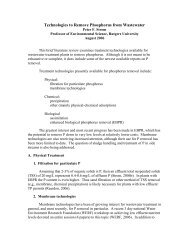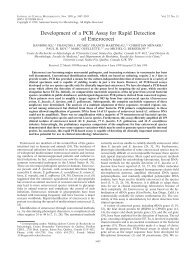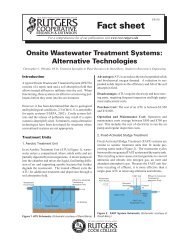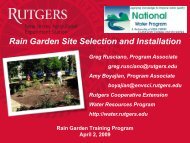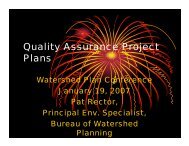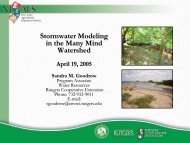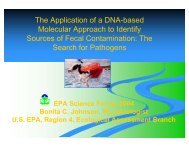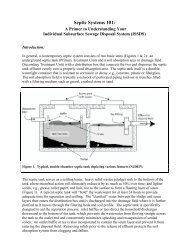Applying HSPF in Cooper River Watershed for Watershed ...
Applying HSPF in Cooper River Watershed for Watershed ...
Applying HSPF in Cooper River Watershed for Watershed ...
Create successful ePaper yourself
Turn your PDF publications into a flip-book with our unique Google optimized e-Paper software.
<strong>Apply<strong>in</strong>g</strong> <strong>HSPF</strong> <strong>in</strong> <strong>Cooper</strong> <strong>River</strong><strong>Watershed</strong> <strong>for</strong> <strong>Watershed</strong>Restoration Plann<strong>in</strong>gZeyuan QiuNew Jersey Institute of TechnologySeptember 20, 2007
Outl<strong>in</strong>e• Why watershed model<strong>in</strong>g• Why <strong>HSPF</strong> <strong>in</strong> <strong>Cooper</strong> <strong>River</strong> <strong>Watershed</strong>• What is <strong>HSPF</strong>• How to Apply <strong>HSPF</strong>• A Plan to Apply <strong>HSPF</strong> <strong>in</strong> <strong>Cooper</strong> <strong>River</strong><strong>Watershed</strong>
Why <strong>Watershed</strong> Model<strong>in</strong>gA watershed model simulates the biologicaland physical processes of runoff andpollutant generation and transport underdifferent land use and managementconditions <strong>in</strong> a watershed. Common reasons<strong>for</strong> watershed model<strong>in</strong>g:• Identify<strong>in</strong>g the sources and causes• Evaluat<strong>in</strong>g the impacts of BMPs• Compar<strong>in</strong>g the management scenarios• Water quality monitor<strong>in</strong>g is limited andexpensive
Why <strong>HSPF</strong> <strong>in</strong> <strong>Cooper</strong> <strong>River</strong><strong>Watershed</strong>?<strong>Cooper</strong> <strong>River</strong> <strong>Watershed</strong> is too complicated<strong>for</strong> other watershed models to handle:• Urban watershed (78 % Urban, 10 % <strong>for</strong>est,8 % wetlands, little others).• Complicated <strong>in</strong>-stream and lake processes• Various pollutants (F. Coli., P, Metals)
SublistStation Name/WaterbodySite IDParametersData Source4<strong>Cooper</strong> <strong>River</strong> at Haddonfield01467150, 01467140,18-CO-4Phosphorus, Fecal Coli<strong>for</strong>mNJDEP/USGS Data, Metal Recon5<strong>Cooper</strong> <strong>River</strong> at Haddonfield01467150, 01467140,18-CO-4Arsenic, Lead, TetrachloroethyleneNJDEP/USGS Data, Metal Recon3<strong>Cooper</strong> <strong>River</strong> at Haddonfield01467150, 01467140,18-CO-4Cadmium, MercuryNJDEP/USGS Data, Metal Recon1<strong>Cooper</strong> <strong>River</strong> at Haddonfield01467150, 01467140,18-CO-4Temperature, pH, Dissolved Oxygen, Nitrate,Dissolved Solids, Total Suspended Solids,Unionized Ammonia, Chromium, Copper,Nickel, Selenium, Z<strong>in</strong>cNJDEP/USGS Data, Metal Recon5<strong>Cooper</strong> <strong>River</strong> at Hopk<strong>in</strong>s Pond<strong>Cooper</strong> <strong>River</strong> atHopk<strong>in</strong>s PondPCBs, Diox<strong>in</strong>NJDEP Fish Tissue Monitor<strong>in</strong>g4<strong>Cooper</strong> <strong>River</strong> at L<strong>in</strong>denwold01467120Fecal Coli<strong>for</strong>mNJDEP/USGS Data5<strong>Cooper</strong> <strong>River</strong> at L<strong>in</strong>denwold01467120PhosphorusNJDEP/USGS Data5<strong>Cooper</strong> <strong>River</strong> at Rt 130 atCamden18-CO-1Arsenic, Lead, Mercury, TetrachloroethyleneNJDEP Metal Recon3<strong>Cooper</strong> <strong>River</strong> at Rt 130 atCamden18-CO-1CadmiumNJDEP Metal Recon1<strong>Cooper</strong> <strong>River</strong> at Rt 130 atCamden18-CO-1Chromium, Copper, Nickel, Selenium, Z<strong>in</strong>cNJDEP Metal Recon3<strong>Cooper</strong> <strong>River</strong> Lake-18<strong>Cooper</strong> <strong>River</strong> LakePhosphorusNJDEP Clean Lakes, NJDEP FishTissue Monitor<strong>in</strong>g5<strong>Cooper</strong> <strong>River</strong> Lake-18<strong>Cooper</strong> <strong>River</strong> LakePCBs, Diox<strong>in</strong>NJDEP Clean Lakes, NJDEP FishTissue Monitor<strong>in</strong>g4<strong>Cooper</strong> <strong>River</strong> N Br at Kresson01467155, 18-CO-2Fecal Coli<strong>for</strong>mNJDEP/USGS Data, Metal Recon5<strong>Cooper</strong> <strong>River</strong> N Br at Kresson01467155, 18-CO-2Phosphorus, Dissolved Oxygen, pH, ArsenicNJDEP/USGS Data, Metal Recon3<strong>Cooper</strong> <strong>River</strong> N Br at Kresson01467155, 18-CO-2Cadmium, MercuryNJDEP/USGS Data, Metal Recon
SublistStation Name/WaterbodySite IDParametersData Source1<strong>Cooper</strong> <strong>River</strong> N Br at Kresson01467155, 18-CO-2Temperature, Nitrate, Dissolved Solids, TotalSuspended Solids, Unionized Ammonia,Chromium, Copper, Lead, Nickel, Selenium,Z<strong>in</strong>cNJDEP/USGS Data, MetalRecon3<strong>Cooper</strong> <strong>River</strong> N Br at Kresson Rd<strong>in</strong> VoorheesAN0186Benthic Macro<strong>in</strong>vertebratesNJDEP AMNET5<strong>Cooper</strong> <strong>River</strong> N Br at <strong>River</strong> Dr <strong>in</strong>Cherry HillAN0188Benthic Macro<strong>in</strong>vertebratesNJDEP AMNET5<strong>Cooper</strong> <strong>River</strong> N Br at Spr<strong>in</strong>gdaleRd <strong>in</strong> Cherry HillAN0187Benthic Macro<strong>in</strong>vertebratesNJDEP AMNET1<strong>Cooper</strong> <strong>River</strong> Park-18<strong>Cooper</strong> <strong>River</strong> ParkMercuryNJDEP Fish Tissue Monitor<strong>in</strong>g5<strong>Cooper</strong> <strong>River</strong> S Br at EveshamRd <strong>in</strong> Cherry HillAN0190Benthic Macro<strong>in</strong>vertebratesNJDEP AMNET5<strong>Cooper</strong> <strong>River</strong> S Br at GibbsboroRd <strong>in</strong> GibbsboroAN0189Benthic Macro<strong>in</strong>vertebratesNJDEP AMNET3<strong>Cooper</strong> <strong>River</strong> S Br at Rt 41 <strong>in</strong>Cherry HillAN0191Benthic Macro<strong>in</strong>vertebratesNJDEP AMNET5<strong>Cooper</strong> <strong>River</strong>, spillway belowEvans Pond<strong>Cooper</strong> <strong>River</strong>, spillwaybelow Evans PondPCBs, Diox<strong>in</strong>NJDEP Fish Tissue Monitor<strong>in</strong>g3<strong>Cooper</strong> <strong>River</strong>-Ma<strong>in</strong> stem aboveEvans Lake<strong>Cooper</strong> <strong>River</strong>-Ma<strong>in</strong> stemabove Evans LakePCBs, Diox<strong>in</strong>NJDEP Clean Lakes, NJDEPFish Tissue Monitor<strong>in</strong>g
What is <strong>HSPF</strong><strong>HSPF</strong> (Hydrological Simulation Program –Fortran) simulates <strong>for</strong> extended periods of timethe hydrologic, water quality, and associatedprocesses on pervious and imperious landsurface and <strong>in</strong> streams and well-mixedimpoundment.• Have the root <strong>in</strong> the Stan<strong>for</strong>d <strong>Watershed</strong> Model(Craw<strong>for</strong>d and L<strong>in</strong>sley, 1966).• Its development has been cont<strong>in</strong>uouslysupported by EPA and USGS.• Its current version <strong>HSPF</strong> V.12 (W<strong>in</strong><strong>HSPF</strong>) is<strong>in</strong>corporated <strong>in</strong>to EPA’s BASINS.
Components Of Water Quality Problems And Pollution
Constituents Sources <strong>in</strong> <strong>HSPF</strong>• Initial storages• Nonpo<strong>in</strong>t load<strong>in</strong>gs• Po<strong>in</strong>t load<strong>in</strong>gs• Atmospheric deposition• Chemical trans<strong>for</strong>mations• Releases from the channel bottom• Atmospheric gas <strong>in</strong>vasion
Land SegmentsLand surface is viewed as three type ofsegments. A segment is a portion of landassumed to have uni<strong>for</strong>m properties.• Pervious land segment (PERLND) withsnow, surface, upper, lower and groundwater zones, which allow <strong>in</strong>filtration• Imperious land segment (IMPLND) withlittle or no <strong>in</strong>filtration such as urban areas• Reaches (RCHRES) such as river,stream, mixed lakes/reservoirs
PERLNDSimulate a perviousland segmentATEMPCorrect airtemperatureSEDMNTSimulate sedimentMSTLAYEstimate solutetransportAGCHEMSNOWSimulate snowand icePSTEMPEstimate soiltemperature(s)PESTSimulate pesticidesPWATERSimulate waterbudgetPWTGASEstimate watertemperature andgas concentrationsPQUALSimulate generalquality constituentsNITRSimulate nitrogenPHOSSimulatephosphorusPERLND Structure ChartTRACERSimulate aconservativetracer
IMPLND Structure ChartIMPLNDPer<strong>for</strong>mcomputationson asegment ofimperviouslandATEMP SNOW IWATER SOLIDS IWTGAS IQUAL(seemodulePERLND)(seemodulePERLND)Simulatewaterbudget<strong>for</strong>imperviouslandsegmentAccumulateand removesolidsSimulatewatertemperaturesanddissolvedgas concs.Simulatequalityconstituentsus<strong>in</strong>g simplerelationshipswith solidsand/or wateryield
RCHRES Structure ChartRCHRESSimulate a reachor mixed reservoirHYDRSimulate hydraulicbehaviorADCALCEstimate advectivebehavior ofconstituentsCONSSimulateconservativeconstituentsHTRCHSimulate heatexchange andwater temperatureSEDTRNSimulate <strong>in</strong>organicsedimentGQUALSimulate generalizedquality constituentsRQUALSimulate constituents<strong>in</strong>volved <strong>in</strong> biochemicaltrans<strong>for</strong>mations
<strong>HSPF</strong> SYSTEM INTERACTIONSMeasured time series:- meteorology- hydrology- po<strong>in</strong>t sourcesGIS coverages:- land use/cover- watersheds- topography- hydrography- soilsWDMUtil<strong>HSPF</strong>GISflat fileWDM fileUCI fileANNIE
Meteorological Time Series Data For <strong>HSPF</strong>PERLND/IMPLNDRCHRESPrecipitationTemp.SnowWaterSedimentSoil Temp.Ag. Chem. *Water[1]HeatGen. Qual.DOPlankton[1][2]RequiredOptionalFor PWATERFor PSTEMPPot. ETAir TemperatureW<strong>in</strong>d SpeedSolar RadiationDewpo<strong>in</strong>t Temp.[1][1][2][3] [5][3][4][5]If volatilizationfrom lakeis simulatedIf photolysisis simulatedIf RCHRESis a lakeCloud Cover[4]
<strong>Watershed</strong> Data Management (WDM) FileA WDM file is a b<strong>in</strong>ary, direct access file thatstores watershed characteristic data and timeseries data, such as channel function table (Ftable), water quality and climate dataWDMDSN 1DSN 2…...DSN ipropertiesrecordsFile Data sets Detailed data
User Control Input (UCI) File• An UCI file is a text file with a specific<strong>for</strong>mat that conta<strong>in</strong>s model parameters andfunction flags that control <strong>HSPF</strong> model<strong>in</strong>gprocesses• Parameters and function flags areorganized <strong>in</strong>to different function blockssuch as “RUN” ended with “END RUN”• Complicity of an UCI file depends on the<strong>HSPF</strong> model functions that would be used
UCIBlocksRun Specification Blocks:GLOBALFILESOPN SEQUENCEOperation Module Blocks:PERLNDIMPLNDRCHRESCOPYetc.Time Series L<strong>in</strong>kage Blocks:Other:EXT SOURCESNETWORKSCHEMATICMASS-LINKEXT TARGETSFTABLESSPEC-ACTIONSCATEGORYMONTH-DATAPATHNAMES
<strong>Apply<strong>in</strong>g</strong> <strong>HSPF</strong> Us<strong>in</strong>g BASINS 4.0MapW<strong>in</strong>dowBASINS 4.0<strong>HSPF</strong>W<strong>in</strong><strong>HSPF</strong> 12.0<strong>HSPF</strong>ParmGenSCNWDMUtil<strong>HSPF</strong>EXPPEST
<strong>Apply<strong>in</strong>g</strong> <strong>HSPF</strong> Us<strong>in</strong>g ArcHydro2<strong>HSPF</strong>• Developed by Nathan Johnson atUniversity of Texas at Aust<strong>in</strong>• Uses the Geodatabase and ModelBuilderto process GIS data and to build the<strong>HSPF</strong> model• Two tool boxs:• “crwr<strong>HSPF</strong>Tools” conta<strong>in</strong>s customGeoprocess<strong>in</strong>g tools to aid <strong>in</strong> <strong>HSPF</strong> modeldevelopment; and• “crwrArcHydro2<strong>HSPF</strong>Models” conta<strong>in</strong>sModelBuilder models which l<strong>in</strong>kGeoprocess<strong>in</strong>g tools together.
Time Series DataThe follow<strong>in</strong>g hourly or daily data aregenerally needed• Inputs: air temperature, precipitation,potential evapotranspiration, w<strong>in</strong>d speed,solar radiation, dewpo<strong>in</strong>t temperature, cloudcover• For calibration: stream flow, sediment,nutrients and pesticide concentration <strong>in</strong>stream
Weather StationsThere are 2 weather station data directlyavailable from EPA BASINS:• Philadelphia• India MillThere might be some weather station datama<strong>in</strong>ta<strong>in</strong>ed by South Jersey RC&D that canbe used <strong>in</strong> the model<strong>in</strong>g.
Redef<strong>in</strong>e the Land UsesThere are 6 types of land uses and 56 subcategories of land uses.Classify them <strong>in</strong>to different types ofPERLND and IMPLND land segmentstak<strong>in</strong>g <strong>in</strong>to consideration of• Soils• Weather• Intensity of land uses• Spatial variations
<strong>HSPF</strong> Parameter EvaluationThere are two types of parameters• Physical parameters derived from land use,soil, topography, and stream <strong>in</strong><strong>for</strong>mation• Calibration parametersPossible sources <strong>for</strong> parameter evaluation• ARM, NPS, and <strong>HSPF</strong> User’s manuals• Applications <strong>in</strong> related areas such<strong>HSPF</strong>Parm• Model calibration process
Model Calibration• Calibration is an <strong>in</strong>teractive procedure ofparameter evaluation and ref<strong>in</strong>ement bycompar<strong>in</strong>g simulated and observed values of<strong>in</strong>terest• Calibration is the most critical process to<strong>HSPF</strong> application• Land surface calibration related to PERLNDand IMPLND segments• Instream Calibration related to RCHRESsegments
BMP Scenarios• Stormwater recharge through ra<strong>in</strong> gardens,dry wells and bio-detention bas<strong>in</strong>s.• Buffers• Street clear<strong>in</strong>g• Various land use/management activitiesMore <strong>in</strong>fo …• http://www.epa.gov/athens/research/model<strong>in</strong>g/ftable/<strong>in</strong>dex.htm
Questions & Comments



